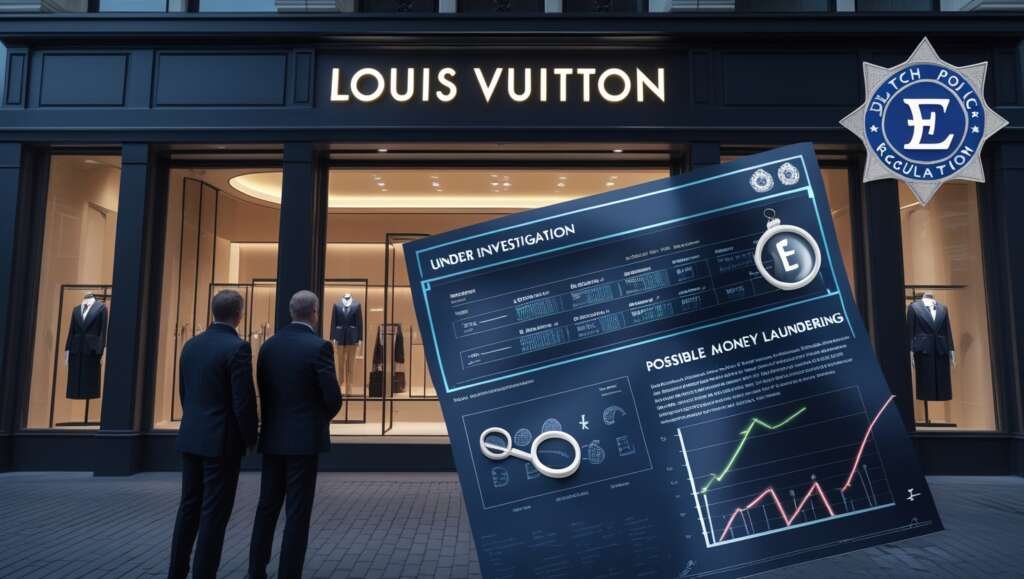Louis Vuitton’s Dutch branch is in hot water. Dutch prosecutors have named Louis Vuitton Netherlands a suspect in a wide-reaching money laundering investigation involving millions of euros in suspicious cash purchases. At the center of the case: a single customer, a stream of high-end handbags, and an underground financial network that appears to have slipped past the eyes of one of fashion’s most prestigious brands.
The case is making waves in both the fashion and legal communities—not just for the size of the alleged laundering scheme, but because it exposes a serious compliance gap in the luxury retail world.
A Luxury Shopper With a Hidden Agenda
It started with regular shopping trips. The customer, identified as Bei W. from Lelystad, reportedly visited Louis Vuitton stores in Amsterdam and Rotterdam dozens of times over an 18-month period. She paid in cash. Not once or twice, but repeatedly. And each time, she made sure to spend just under €10,000 which is the legal limit above which stores are required to file a report with the Dutch Financial Intelligence Unit.
That alone might not have raised alarms. But Bei W. also used different email addresses and aliases, frequently changed her contact details, and came prepared with large sums of cash, often neatly bundled. It was, in hindsight, a textbook example of “structuring” or “smurfing”: a tactic used to avoid triggering scrutiny from financial regulators.
Despite the obvious red flags, the transactions went ahead. Over time, she racked up close to €3 million in purchases—all in cash. Prosecutors say Louis Vuitton should have recognized the pattern. Instead, the company processed each sale without incident.
An Insider Connection
What makes this case especially troubling for prosecutors is the alleged involvement of a Louis Vuitton employee. According to court documents, a sales associate provided Bei W. with personalized service, notified her when new inventory arrived, and helped her manage the repeated transactions.
This wasn’t just about customer service. The employee allegedly went out of their way to avoid drawing attention to the purchases. In doing so, prosecutors argue, the associate not only violated internal policies but may have helped facilitate a criminal operation.
While the employee hasn’t been charged, their role is central to the prosecution’s claim that Louis Vuitton didn’t just fail to detect the laundering, it enabled it.
Handbags and Hidden Cash
Investigators eventually raided several locations tied to the case. What they found underscored the scale of the operation. In storage units and backrooms, they discovered hundreds of Louis Vuitton items mostly handbags, many still in their original boxes. These weren’t part of a personal collection. They were being prepared for shipment, mostly to China and Hong Kong.
Authorities believe Bei W. was acting on behalf of a wider criminal network. The luxury goods she purchased were meant to be resold abroad, allowing the network to turn illicit euros into clean foreign currency.
This method using high-end products to wash dirty money is known as trade-based money laundering. It’s not new. But the Louis Vuitton case shows just how easily it can slip through the cracks, especially in an industry where large cash purchases are often seen as a sign of exclusivity, not suspicion.
The Legal Stakes for Louis Vuitton
Dutch law requires businesses to report any cash transaction over €10,000. But the rules go further. If a series of smaller purchases suggest an attempt to avoid reporting or if the buyer behaves in a way that seems suspicious, the business is obligated to notify authorities, regardless of the amount.
In this case, prosecutors believe Louis Vuitton should have connected the dots. They argue that the repeated cash payments, use of fake names, and coordinated behavior should have triggered an internal investigation and a report to the Financial Intelligence Unit.
Louis Vuitton’s Dutch division is now under the microscope. Authorities officially named it a suspect—not because there’s a guilty verdict, but because prosecutors think they’ve got enough on paper to dig deeper.
If the case escalates and ends in a conviction, the fallout could be brutal. We’re talking big fines, enforced policy overhauls, and a reputational hit that’s hard to shake especially for a brand that’s all about luxury, control, and flawless image.
A Global Brand, Local Problems
Louis Vuitton, a subsidiary of French luxury giant LVMH, is one of the most recognizable fashion houses in the world and one of the most profitable luxury provider. Louis Vuitton’s handbags, wallets, and accessories are regarded as status symbols around the world, particularly Asia, which is still generating a lot of demand.
However, that same prestige and status makes Louis Vuitton goods a prime opportunity for money launderers. Goods can be easy to monetize and are often resold for similar, or even higher, prices than retail especially when inventories are limited or controlled by region.
Although Louis Vuitton has specified procedures to vet transactions and train staff, critics state that the reality is much less robust and that checks and balances are non-existent in practice. Sales associates are nearly powerless to stop big-spending clients, and clients who make large purchases are often people with influence who do not come under the same scrutiny.
This case may force LVMH and other players in the luxury goods market to consider alternative practices.
The Role of Underground Banking
One of the most striking elements of the case is how Bei W. obtained the cash in the first place. Prosecutors believe she worked with an “underground banker” who is an individual or network operating outside of the traditional financial system.
These bankers would usually generate illegal money in one country and pay clean money in another country through a series of commercial transactions that completely look unrelated. It is a system based on anonymity, speed and complexity, making it extremely difficult for authorities to detect the activity.
The underground bank made it easy for the group to obtain euros in the Netherlands and launder it through luxury purchases, thus allowing for them to clean large amounts of criminal money very easily. They continued to do that in plain sight for a while.
Implications for the Luxury Sector
The consequences of this case extends well beyond Louis Vuitton. Regulators are now looking for the entire luxury goods space to comply with more stringent standards, develop better training programs for staff, and adopt technology that can identify and flag anomalous transactions as that arise in real-time.
Financial crime experts have been signalling for some time that luxury retailers represent a weak point in the battle against money laundering. They are not specifically under reporting obligations that stringently apply to banks. When compliance programs exist, they’re often more focused on fraud prevention or brand protection than anti-money laundering. This case may change that.
If Louis Vuitton Netherlands is officially charged and if it is convicted, it could be ground-breaking for future prosecutions. It would also send out real signal: ignorance is not a defense, and prestige does not excuse futility.
Louis Vuitton’s Response
So far, Louis Vuitton has kept a low profile. The spokesperson confirmed the organization is working with the authorities, as well as conducting its own internal review. As of now, no one from LVMH has offered to comment about the alleged involvement of its employee or about the type of transactions involved.
Skepticism is building. Investors are watching it closely along with the customers. In the marketplace today, brand perception is paramount and a scandal about money laundering can cause stigmatic and reputational damage.
The organization may be compelled to change its policies, train employees better, and establish more tested compliance systems to avoid such breaches in compliance. This could include adding customer due diligence, cash transaction limits, and working closer with the authorities on financial investigations.
The Road Ahead
Bei W. has presented herself in court already and the trial is anticipated to continue in the next year. In the meantime, the prosecutors are ongoing a continued investigation. They have not ruled out potential formal charges against Louis Vuitton Netherlands nor have they ruled out the chances of potential suspects whether inside or outside of the company playing a role.
Whether the legal case ends up proceeding or not, the case against Louis Vuitton has already provided extremely valuable lessons. It is a stark reminder that even the best and sought after brands can get pinned under criminal conspiracy, especially if the items and systems put in place to curb abuses are ignored or circumvented.
As for Louis Vuitton, it is clear that regardless of the outcome, this is not strictly just a legal matter but it is a reputational examination. And, how they choose to handle the situation, whether openly, clearly or decisively, will determine if they exit the situation respectfully or brutally injured. This case is also a learning lesson for other luxury retailers to step up as no influence or power can protect a brand if it gets entangled in a financial lawsuit.
Compliance is the key and is extremely paramount in today’s digital day and age.




